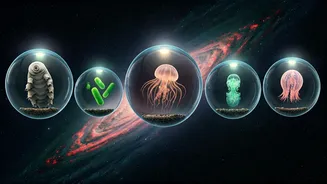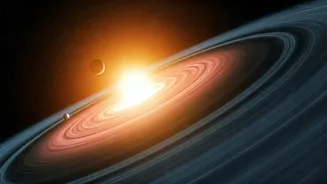Enceladus: Icy Moon
Enceladus, a moon of Saturn, is gaining attention for its potential to harbor life. Beneath its icy surface lies a global ocean, and geysers erupt, spewing
water and other materials into space. These geysers have captured the interest of scientists, particularly with the discovery of organic molecules within the plumes. These molecules are essential to life as we know it, prompting further investigation into their formation and origins. The presence of organic molecules in the geysers suggested the possibility of a habitable environment, sparking significant curiosity about the conditions under which these molecules were created and how they might relate to the potential for life within Enceladus's ocean. This has led to intense research to comprehend the moon's composition and internal processes.
Cosmic Rays Explained
Cosmic rays are high-energy particles that originate from outside our solar system and travel through space at close to the speed of light. These particles are composed primarily of protons, but they can also include atomic nuclei. When cosmic rays encounter objects, such as moons or planets, they interact with the materials on their surfaces. The impact of cosmic rays can cause chemical reactions, including the breaking and forming of molecular bonds. These reactions are important, as they provide an avenue through which molecules, like the organic molecules detected on Enceladus, are able to form. The constant bombardment of cosmic rays, therefore, helps drive the synthesis of complex molecules in various environments throughout the universe, offering clues about the origins of life and the possibility of life beyond Earth.
Cosmic Rays on Enceladus
Scientists have found that cosmic rays play a vital role in creating organic molecules on Enceladus. As these high-energy particles hit the moon's icy surface and the material ejected by its geysers, they provide the energy needed to drive the chemical reactions that form complex organic molecules. These include those found within the plumes, which are a mix of ice grains, water vapor, and organic compounds. The research indicates that cosmic rays can significantly impact the chemical composition of Enceladus. This is an exciting finding, as it suggests that even in extremely harsh environments, like on icy moons far from the sun, the building blocks for life might emerge. Understanding this process could broaden our understanding of how life can develop throughout the universe.
Implications of Research
The findings have far-reaching implications for astrobiology and the search for life beyond Earth. They suggest that the influence of cosmic rays on icy moons could provide an environment capable of generating the compounds vital for life. It also suggests that the building blocks of life might form in various places throughout the cosmos, not exclusively in areas similar to Earth. Studying Enceladus and similar celestial bodies could unlock valuable insights into the formation of organic molecules. As scientists continue to explore Enceladus and other icy moons, they aim to further understand the chemical processes that occur there and the conditions that might allow for the presence of life. Further studies of the composition of the plumes and how cosmic rays interact with the moon's surface will provide a better understanding of the potential for life in these regions.













